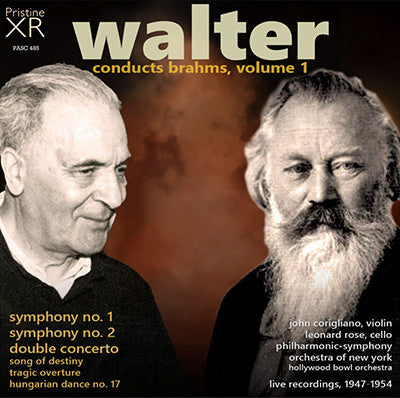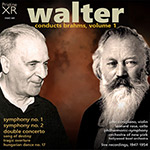
This album is included in the following sets:
This set contains the following albums:
- Producer's Note
- Full Track Listing
- Cover Art
- NY Times, 1951
Bruno Walter's 1951 Brahms Cycle with the NY Philharmonic - and more!
"These concerts apparently find Mr. Walter at the very zenith of his powers, absorbed in a task which is especially dear to him" - NY Times
This series is based around what survives of Bruno Walter's fabulous 1951 series of Brahms concerts with the New York Philharmonic, together with other live performances which either fill gaps in the 1951 recordings or, in the case of the German Requiem (Vol. 3), add to the 1951 programme. A number of major recordings, including two of the symphonies, have never been issued before; in other cases we have gained access to sonically superior sources to those used in previous releases.
There is some variation in sound quality across the recordings, some of which have required extensive repair and restoration. What shines throughout is the fabulous musicality of these truly historic concert accounts of Brahms' music, as given by Walter and the New York Philharmonic.
One of the highlights of this first of three 2-CD volumes is a previously-unissued recording of the First Symphony. This was original played alongside the Tragic Overture and the Violin Concerto, neither of which has apparently survived in usable recorded form (a correspondent reports "a horrible transfer to a defective private LP" of the Violin Concerto with Francescatti); here we've replaced the Overture with a later New York performance, a later disc will include a 1953 NY recording of the Violin Concerto. The Song of Destiny which completes the first disc was not performed at the New York concerts - the present recording is taken from a 1947 Hollywood Bowl concert, conducted in the open air by Walter to the (occasional) gentle accompaniment of crickets chirruping in the background.
The second disc here offers the third concert programme in full. Of the recordings it is the Double Concerto which is perhaps of greatest interest to collectors - previous outings on various dubious Italian labels have offered badly muffled, congested and inferior sound. By comparison it is clean and clear here, as are the other two recordings. I had to deal with occasional peak distortion in the first movement of the Second Symphony where it was originally recorded at levels which overloaded during the loudest sections, something I've endeavoured to bring under control here.
Volume Two in this series will complete the symphonies, accompanied by two concertos, whilst the final volume will include a previously unissued recording of the Piano Concerto No. 1 from the 1951 New York series, together with a later performance of A German Requiem and other works.
Andrew Rose-
BRAHMS Schicksalslied (Song of Destiny), Op. 54
Hugo Strelitzer Choir, Hollywood Bowl Orchestra
-
BRAHMS Tragic Overture, Op. 81
-
BRAHMS Symphony No. 1 in C minor, Op. 68
-
BRAHMS Hungarian Dance No. 17 in F-sharp minor
-
BRAHMS Double Concerto for violin and cello in A minor, Op. 102
John Corigliano, violin
Leonard Rose, cello
-
BRAHMS Symphony No. 2 in D major, Op. 73
Philharmonic-Symphony Orchestra of New York
Bruno Walter, conductor
*Schicksalslied: 7 October 1947
Tragic Overture: 19 December 1954
Symphony No. 1: 21 January 1951
Hungarian Dance: 4 February 1951
Double Concerto: 4 February 1951
Symphony No. 2: 28 January 1951
except *Hollywood Bowl, Los Angeles
New York Times, 1951:
WALTER LAUNCHES HIS BRAHMS CYCLE
He Conducts Philharmonic in Concert of Master’s Works
Olin Downes The New York Times, 19 January 1951

